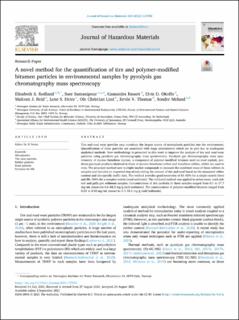A novel method for the quantification of tire and polymer-modified bitumen particles in environmental samples by pyrolysis gas chromatography mass spectroscopy
Rødland, Elisabeth Strandbråten; Samanipour, Saer; Rauert, Cassandra; Okoffo, Elvis D.; Reid, Malcolm James; Heier, Lene S; Lind, Ole Christian; Thomas, Kevin V; Meland, Sondre
Peer reviewed, Journal article
Published version
Permanent lenke
https://hdl.handle.net/11250/2988753Utgivelsesdato
2021Metadata
Vis full innførselSamlinger
Sammendrag
Tire and road wear particles may constitute the largest source of microplastic particles into the environment. Quantification of these particles are associated with large uncertainties which are in part due to inadequate analytical methods. New methodology is presented in this work to improve the analysis of tire and road wear particles using pyrolysis gas chromatography mass spectrometry. Pyrolysis gas chromatography mass spectrometry of styrene butadiene styrene, a component of polymer-modified bitumen used on road asphalt, produces pyrolysis products identical to those of styrene butadiene rubber and butadiene rubber, which are used in tires. The proposed method uses multiple marker compounds to measure the combined mass of these rubbers in samples and includes an improved step of calculating the amount of tire and road based on the measured rubber content and site-specific traffic data. The method provides good recoveries of 83–92% for a simple matrix (tire) and 88–104% for a complex matrix (road sediment). The validated method was applied to urban snow, road-side soil and gully-pot sediment samples. Concentrations of tire particles in these samples ranged from 0.1 to 17.7 mg/mL (snow) to 0.6–68.3 mg/g (soil/sediment). The concentration of polymer-modified bitumen ranged from 0.03 to 0.42 mg/mL (snow) to 1.3–18.1 mg/g (soil/sediment).
